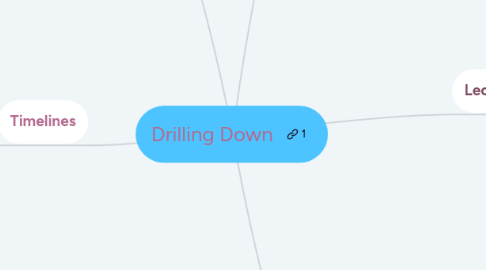
1. Mapping
1.1. Using a new Concept Map for learning
2. Timelines
2.1. Short term and Long term
2.1.1. Short term timelines
2.1.1.1. What goals to establish?
2.1.1.1.1. The main goals are for students to comprehend/learn material.
2.1.1.1.2. Determine learning outcomes via assessments.
2.1.1.1.3. When to administer quizzes and tests.
2.1.1.2. How long should certain lessons take?
2.1.1.2.1. Would depend on the subject matter.
2.1.1.2.2. Are we looking at weekly?
2.1.1.2.3. Will larger subject be broken into smaller components?
2.1.1.3. What are the learning objectives in this given timeline?
2.1.1.3.1. For students to gain an understanding of material prior to moving forward.
2.1.1.3.2. Break larger material into weekly chunks.
2.1.1.3.3. Test knowledge learned through assessments.
2.1.2. Long term timelines
2.1.2.1. What type of assessments to include?
2.1.2.1.1. Peer Review.
2.1.2.1.2. Online.
2.1.2.1.3. Instructor/Expert.
2.1.2.2. Should we include assessments during the course?
2.1.2.2.1. This would mean continual feedback.
2.1.2.2.2. Could be viewed as overkill.
2.1.2.2.3. Use only a few at key points during the course, i.e., midterm, end of course.
2.1.2.3. How are we going to use the information from the assessments?
2.1.2.3.1. Use data to improve the course.
2.1.2.3.2. Data should also confirm validity of students gained knowledge.
2.1.2.3.3. Use data to improve instructor.
3. Presentations
3.1. Power Point slides
3.1.1. Factors contributing to the problem
3.1.1.1. Just bullet points
3.1.1.2. Dense and boring
3.1.1.3. Non interactive
3.1.1.4. Handed out as study guides
3.1.2. Questions raised by problem
3.1.2.1. How to make presentations more engaging
3.1.2.2. Should be short, concise and to the point
3.1.2.3. What do students do after the presentation
3.1.2.4. Part of the class should be used for discussions, group presentations, etc.
4. Lecture
4.1. Apprehension about technology
4.1.1. Questions raised by problem
4.1.1.1. What technical tools is the instructor personally using?
4.1.1.1.1. Does the instructor use a PC/Laptop?
4.1.1.1.2. Does he use a smartphone?
4.1.1.1.3. Has he ever used an overhead projector?
4.1.1.2. Are the students fully engaged in the learning process?
4.1.1.2.1. Are all of the class materials handouts?
4.1.1.2.2. What are the discussions based on?
4.1.1.2.3. Does he assign groups projects?
4.1.1.3. Need to use technology as a fill in?
4.1.1.3.1. Instructor will need to learn some technology.
4.1.1.3.2. What resources are available for him?
4.1.1.4. Is he willing to have someone co-instruct with him (learning vehicle).
4.1.1.4.1. Instructor must be willing to accept technological assistance.
4.1.1.4.2. Needs to loosen up in terms of using other peoples work.
4.1.1.4.3. This avenue will engage his students more both in and outside of the class.
5. Disussions
5.1. How to make the discussions more inclusive to all students?
5.1.1. Discussions are dominated by a only a few.
5.1.1.1. Employ both classroom & online etiquette guidelines.
5.1.1.2. Monitoring online discussions.
5.1.1.3. Reinventing the way classrooms discussions are performed.
5.1.2. Students are ill prepared.
5.1.2.1. Have students research topics relevant to the lesson (tie ins).
5.1.2.2. Allow students to search for information related to the lessons online.
5.1.2.3. Give students a syllabus with dates in regards to each days lesson/discussion.
5.1.3. Will the online environment allow for more participation from other students?
5.1.3.1. Discussion questions should be engaging to all participants.
5.1.3.2. Students must agree or disagree with other students in a positive way, giving solid reason(s) as to why they disagree.
5.1.3.3. Explain that online discussions are a part of the grading system.
